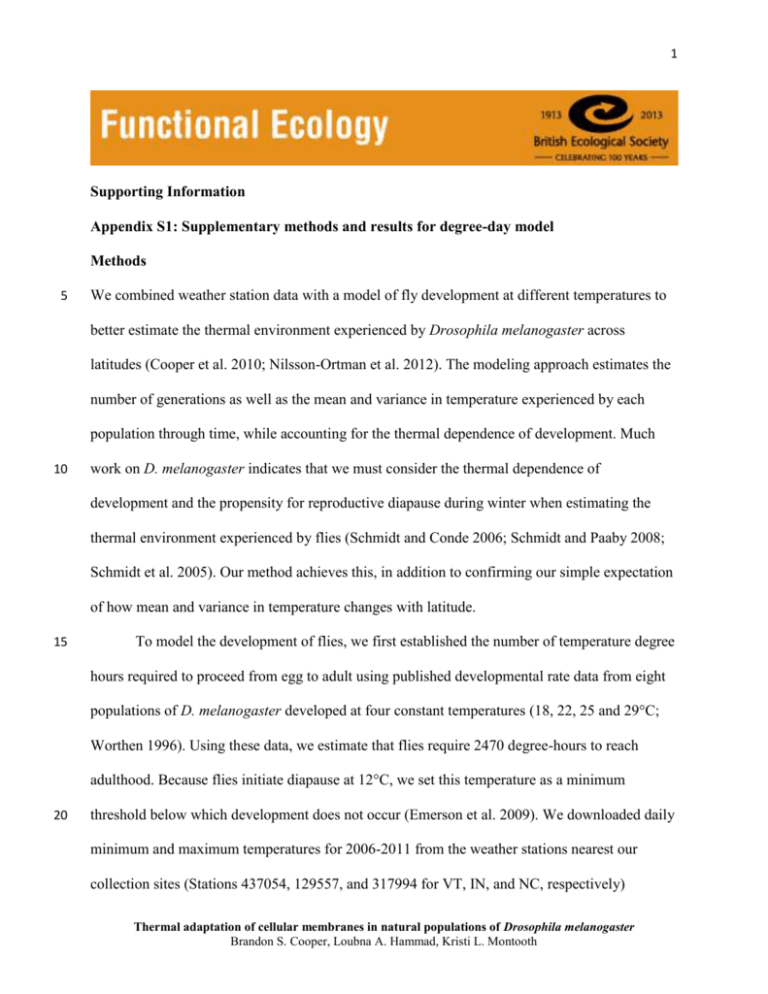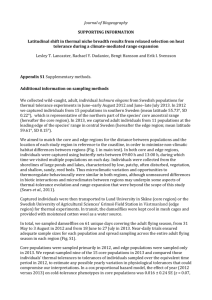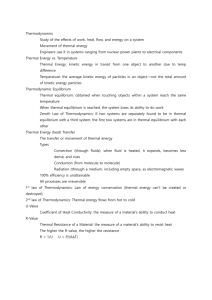fec12264-sup-0002-AppS1-TblS1-S2-FigS1
advertisement

1 Supporting Information Appendix S1: Supplementary methods and results for degree-day model Methods 5 We combined weather station data with a model of fly development at different temperatures to better estimate the thermal environment experienced by Drosophila melanogaster across latitudes (Cooper et al. 2010; Nilsson-Ortman et al. 2012). The modeling approach estimates the number of generations as well as the mean and variance in temperature experienced by each population through time, while accounting for the thermal dependence of development. Much 10 work on D. melanogaster indicates that we must consider the thermal dependence of development and the propensity for reproductive diapause during winter when estimating the thermal environment experienced by flies (Schmidt and Conde 2006; Schmidt and Paaby 2008; Schmidt et al. 2005). Our method achieves this, in addition to confirming our simple expectation of how mean and variance in temperature changes with latitude. 15 To model the development of flies, we first established the number of temperature degree hours required to proceed from egg to adult using published developmental rate data from eight populations of D. melanogaster developed at four constant temperatures (18, 22, 25 and 29°C; Worthen 1996). Using these data, we estimate that flies require 2470 degree-hours to reach adulthood. Because flies initiate diapause at 12°C, we set this temperature as a minimum 20 threshold below which development does not occur (Emerson et al. 2009). We downloaded daily minimum and maximum temperatures for 2006-2011 from the weather stations nearest our collection sites (Stations 437054, 129557, and 317994 for VT, IN, and NC, respectively) Thermal adaptation of cellular membranes in natural populations of Drosophila melanogaster Brandon S. Cooper, Loubna A. Hammad, Kristi L. Montooth 2 (Williams et al. 2006). To extract predicted hourly temperatures from these data, we fit a 25 sinusoidal function to the maximum and minimum temperatures for each day (Campbell and Norman 1998). To estimate the parameters of interest, degree hours were summed until 2470 degree-hours were reached, at which time a new generation began. We then calculated a mean temperature for each generation, and a grand mean temperature across all generations. The standard deviation of the grand mean provided an estimate of variance in temperature across 30 generations. While others have estimated within-generation thermal variance (Nilsson-Ortman et al. 2012), we did not estimate this component. In contrast to seasonal variation, behavior is more likely to buffer thermal variation within generations, complicating estimates of thermal variability over small temporal scales. 35 Results Our model qualitatively agrees with summary statistics of raw weather data (Table S1). As expected, mean temperatures decrease and thermal variances increase with latitude (Table S1). However, quantitative differences between summary statistics and estimates from our model support the biological relevance of this approach. The model estimates of mean temperatures are 40 higher, and estimates of thermal variance are lower, than the raw mean and variance of daily minima and maxima from 2006-2008. This stems from the model accounting for the thermal dependence of development; flies are not active and generations are not proceeding during the coolest and most variable winter months. Further, because VT flies experience cooler temperatures than the other populations, fewer generations progress in VT, and periods of Thermal adaptation of cellular membranes in natural populations of Drosophila melanogaster Brandon S. Cooper, Loubna A. Hammad, Kristi L. Montooth 3 45 reproductive quiescence increase relative to IN and NC flies. Together, our model estimates support the simple predictions based on latitude alone – that selection on membrane specialization in response to cooler mean temperature and on membrane generalization (i.e., plasticity) in response to thermal heterogeneity should be highest in VT. 50 Literature Cited Campbell, J.S. & Norman, J.M. (1998) An Introduction to Environmental Biophysics. Springer, New York. Cooper, B.S., Czarnoleski, M. & Angilletta, M.J. (2010) Acclimation of thermal physiology in 55 natural populations of Drosophila melanogaster: a test of an optimality model. Journal of Evolutionary Biology, 23, 2346-2355. Emerson, K.J., Bradshaw, W.E. & Holzapfel, C.M. (2009) Complications of complexity: integrating environmental, genetic and hormonal control of insect diapause. Trends in Genetics, 25, 217-225. 60 Nilsson-Ortman, V., Stoks, R., De Block, M. & Johansson, F. (2012) Generalists and specialists along a latitudinal transect: patterns of thermal adaptation in six species of damselflies. Ecology, 93, 1340-1352. Schmidt, P.S. & Conde, D.R. (2006) Environmental heterogeneity and the maintenance of genetic variation for reproductive diapause in Drosophila melanogaster. Evolution, 60, 65 1602-1611. Thermal adaptation of cellular membranes in natural populations of Drosophila melanogaster Brandon S. Cooper, Loubna A. Hammad, Kristi L. Montooth 4 Schmidt, P.S. & Paaby, A.B. (2008) Reproductive diapause and life-history clines in North American populations of Drosophila melanogaster. Evolution, 62, 1204-1215. 70 Schmidt, P.S., Paaby, A.B. & Heschel, M.S. (2005) Genetic variance for diapause expression and associated life histories in Drosophila melanogaster. Evolution, 59, 2616-2625. Williams, C.N., Jr., Menne, M.J., Vose, R.S. & Easterling, D.R. (2006) United States Historical Climatology Network Daily Temperature, Precipitation, and Snow Data. ORNL/CDIAC118, NDP-070. Available on-line (http://cdiac.ornl.gov/epubs/ndp/ushcn/usa.html) from 75 the Carbon Dioxide Information Analysis Center, Oak Ridge National Laboratory, U.S. Department of Energy, Oak Ridge, Tennessee. Worthen, W.B. (1996) Latitudinal variation in developmental time and mass in Drosophila melanogaster. Evolution, 50, 2523-2529. Thermal adaptation of cellular membranes in natural populations of Drosophila melanogaster Brandon S. Cooper, Loubna A. Hammad, Kristi L. Montooth 5 80 Table S1. Summary of weather data and the estimated mean temperature and thermal variance experienced by D. melanogaster across latitudes accounting for thermal effects on development. Population East Calais, VT, USA Latitude/ Mean temperature Estimated mean Thermal Estimated thermal Estimated number Station ID1 (°C)2 temperature (°C)3 variation (°C) 4 variation (°C)5 of generations6 44° 25' N/ 7.66 16.48 12.50 6.16 55 11.55 19.51 12.12 5.87 88 15.77 21.71 11.12 5.64 123 437054 Bloomington, IN, USA 39° 59' N/ 129557 Raleigh, NC, USA 35° 30' N/ 317994 1 The latitude and station identification numbers of the weather stations used in our analyses. The mean temperature from 2006-2011 calculated using daily minimum and maximum temperatures. 3 The grand mean of the estimated mean temperatures for each generation using a degree-hour model (Cooper et al. 2010). 4 The standard deviation temperatures between 2006-2011 calculated using daily minimum and maximum temperatures. 5 The standard deviation of the grand mean temperature, our estimate for thermal variation across generations, using a degree-hour model (Cooper et al. 2010). 6 The estimated number of generations between 2006-2011 from a degree-hour model (Cooper et al. 2010). Differences represent variation among populations in the length of reproductive quiescence, and in the number of generations during the active season. 2 85 Thermal adaptation of cellular membranes in natural populations of Drosophila melanogaster Brandon S. Cooper, Loubna A. Hammad, Kristi L. Montooth 6 90 Table S2. Populations do not differ in GPL plasticity in response to adult thermal shifts (see Table 2 for P-values), but the magnitude of adult responses for all populations depends on the direction of the thermal shift. Plasticity in PE/PC is greater when adults are shifted to 26C, relative to 16C (tpaired = 5.2139, df = 2, P = 0.035), while plasticity in the degree of lipid saturation is greater when adults are shifted to 16C, relative to 26 C (tpaired = 11.7169, df = 2, P = 0.007). Treatment Adult shift to 16C Adult Trait ∆PE/PC ∆Saturation Adult shift to 26C ∆PE/PC ∆Saturation Population Mean S.E. East Calais, VT, USA 0.123 0.029 Bloomington, IN, USA 0.101 0.033 Raleigh, NC, USA 0.115 0.027 East Calais, VT, USA 0.012 0.003 Bloomington, IN, USA 0.015 0.003 Raleigh, NC, USA 0.016 0.004 East Calais, VT, USA 0.195 0.039 Bloomington, IN, USA 0.144 0.050 Raleigh, NC, USA 0.202 0.028 East Calais, VT, USA 0.002 0.003 Thermal adaptation of cellular membranes in natural populations of Drosophila melanogaster Brandon S. Cooper, Loubna A. Hammad, Kristi L. Montooth 7 Bloomington, IN, USA 0.003 0.002 Raleigh, NC, USA 0.007 0.003 95 100 Thermal adaptation of cellular membranes in natural populations of Drosophila melanogaster Brandon S. Cooper, Loubna A. Hammad, Kristi L. Montooth 8 Figure S1. Developmental reaction norms for lipid saturation. All populations increase lipid 105 unsaturation (i.e., increased polyunsaturation relative to monounsaturation) when developed at cool temperatures as predicted by models of homeoviscous adaptation, but in contrast to PE/PC plasticity, genotypes from VT do not have increased plasticity of this trait. A) The proportion of the membrane composed of polyunsaturated GPLs increased during development at 16C, and thus B) the proportion of the membrane composed of monounsaturated GPLs decreased during 110 development at 16C. Data are means +/- s.e. from all genetic lines within each population. Thermal adaptation of cellular membranes in natural populations of Drosophila melanogaster Brandon S. Cooper, Loubna A. Hammad, Kristi L. Montooth






